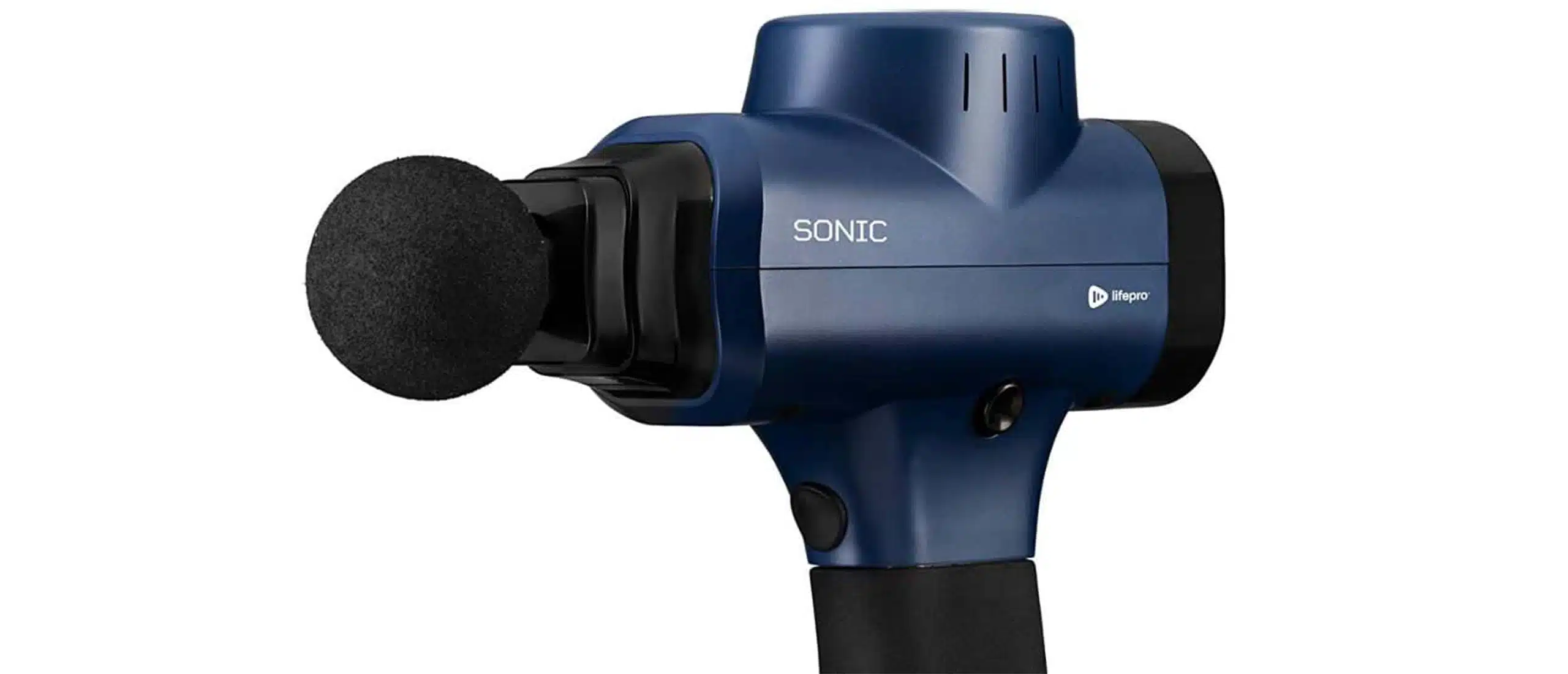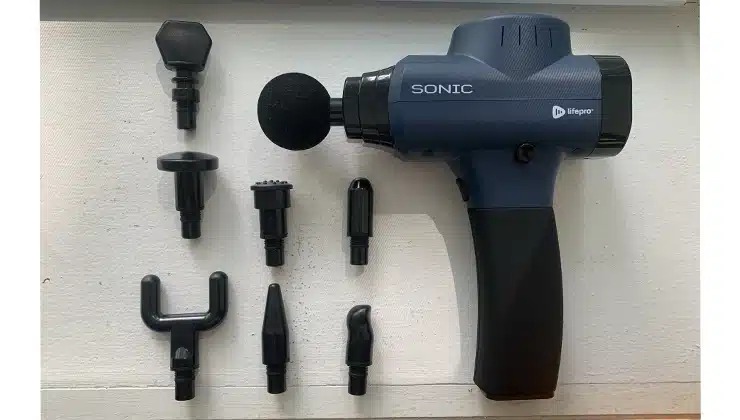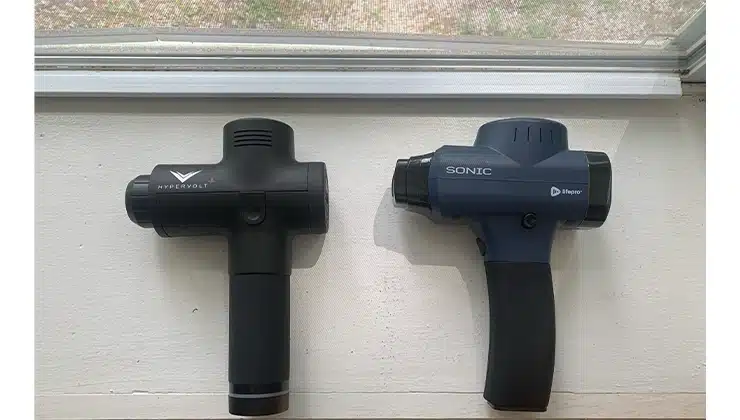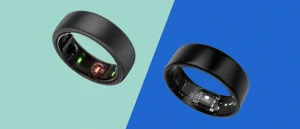Home Lifestyle Gear & Tech Is This Massage Gun a Hypervolt at Half the Price?

Is This Massage Gun a Hypervolt at Half the Price?
If you’re Googling around for massage guns you’ve likely run into Hyperice’s series of Hypervolt massage tools, or perhaps even Theragun’s myriad of similar products. Each costs $300 or more for a full-sized version, though, and, in case you weren’t aware, that is a lot of money for a product designed to rapidly punch your muscles. Enter the Lifepro Sonic Pro Massage Gun, a popular alternative to both that’s nearly half the price (typically about $130). Is there anything you get for $300 that you don’t get for $130? We tested the Lifepro Sonic Pro to find out.
What Is Lifepro?
Lifepro, the brand, started when two friends both did their ACLs in in the space of a few months. Per the brand, the pair bought and were frustrated with all sorts of home gym and recovery equipment, so, naturally, they started their own company to do it better.
Cute company founding stories aside, Lifepro’s products generally cost just below the mega-brands of fitness and recovery. They sell muscle massagers, red light therapy equipment, stationary bikes, adjustable dumbbells, treadmills, and more. Most of the products look the part, but we obviously want to know if they act it, too.

How Does the Lifepro Sonic Pro Massage Gun Work?
Percussion
Measuring and codifying percussion can get confusing. It’s a mixture of the power of the tool and the depth at which it “punches.” Many cheap percussion massagers boast high power numbers, but low depth; many expensive percussion massagers feature less raw power, but much greater depth.
The LifePro errs toward power and moderate depth. Its “stall force,” as its called, is 75 pounds. Hypervolts, for comparison, are typically about 15 pounds less. It doesn’t list its stroke depth, but it is noticeably shorter than the Hypervolt I have. The differences in power are felt most at high speeds, where you’re meant to be receiving deep-tissue relief. The difference in stroke length is felt more in the low and mid-range speed settings, where the depth of each stroke can be felt more than at high speeds.
Speed
A lot of fuss is made over the number of speed settings on massage guns. Ultimately, I’ve found five or more to be sufficient. There is very little functional difference between a 8-speed and a 15-speed. With that said, Lifepro Pro Sonic is a 15-speed, and I found myself using probably four of them at most. Perhaps there are people out there for which 11 more speeds is helpful, but I’m not one of them.
The 15 speeds range from 1,200 to 3,000 RPM (or as I call them, punches per minute). This is roughly in line with its higher-end competition, though it the lower setting on the Lifepro is a fair bit lower than the Hypervolt and other comparable options. I actually quite like the lowest setting; it’s great for a post-massage rollover.
Battery
It’s got a 2600mAh battery that lasted about two hours and 45 minutes for me, or for about 15 or so sessions. This is almost the exact same as the Hypervolt I have, and I use roughly the same routine for both.
The one difference worth noting is recharge time. The Hypervolt’s battery seems to charge to full more quickly than the Lifepro’s by about an hour and change. It’s a small difference ultimately, because it’s not overly difficult to put the thing on the charger when you’re done with it, but it is a potential pain point.
The Experience
It’s easy to get caught up in the numbers when comparing similar products, but it’s impossible to know if something holds up unless you get hands on with it.
The Lifepro Sonic Pro (a horrible name, in my opinion) comes in a soft carrying case with all the various heads, attachments, chargers loaded neatly within. For something almost one-third the price of the super-premium percussion massagers, it doesn’t immediately scream this is cheap.
In fact, in most ways—or at least in those ways that a normal human being could discern—it stands up to the pricy competition (I also own a Hypervolt Plus). It’s powerful, it has plenty of speed settings, and all the bells and whistle a person could need.
There are two things that I didn’t like: the build quality and some inconsistencies with power settings.
The construction of the product isn’t overtly bad, but it is noticeably worse than the Hypervolt, and feels tacky in comparison. Though it’s not a dealbreaker, the plastic main body of the device is significantly lighter than the handle, which creates an awkwardly imbalanced massage gun. I much prefer the weight distribution of the Hypervolt in comparison.
Power setting inconsistencies were more of a pain, but they only occurred three or four times over the course of a month of use. Unlike the Hypervolt and other premium massage guns, the Lifepro ratchets up power in steps, rather than a quick escalation of speed. When I increased the power from level one to level two, on a few occasions, it seemed to get stuck in this power stepping mode, and it would climb to the highest setting before jumping back down to the lowest. It’s a bit odd, and it didn’t happen enough for me to dismiss the product, but it’s worth reporting. A simple off-on restart seemed to fix whatever the issue was.

The Competition
The key market the Lifepro Sonic Pro is targeting are folks that don’t see how a massage gun could reasonably cost $400+, as some from Hypervolt and Theragun do.
From a utility perspective, having used the expensive competition for years prior to testing the Lifepro, I’d so the Lifepro compares favorably. It’s got loads of power, and despite some quirks with construction and onboard tech, it does the trick. Ultimately, the job of this tool isn’t overly complex for most users—relieve tight muscles, treat yourself with a massage after a long day, or plop it at your desk to use like a fidget spinner. There are loads of niche features the expensive options have that I find mostly pointless (why in god’s name do I need to connect the massage gun to an app?), and the Lifepro drops them in favor of a more function-first product.
The Bottom Line
Despite mild issues with the Lifepro Pro Sonic’s slightly awkward weight distribution and power scaling, its performance in its primary task—relieving muscles—was very good, and almost indiscernible from my Hypervolt, which costs almost three-times as much.










